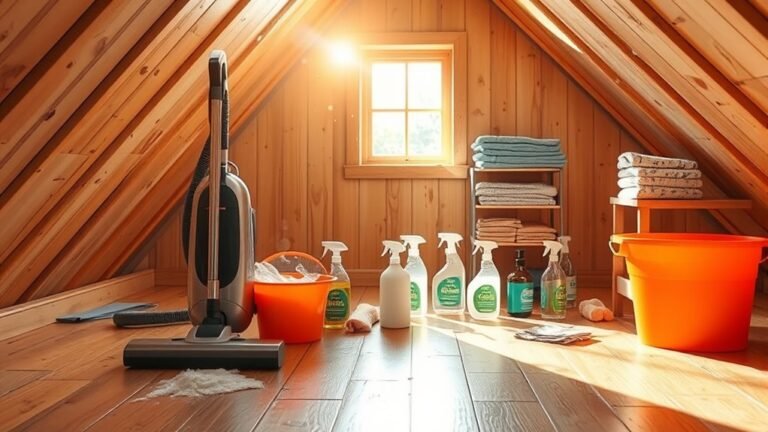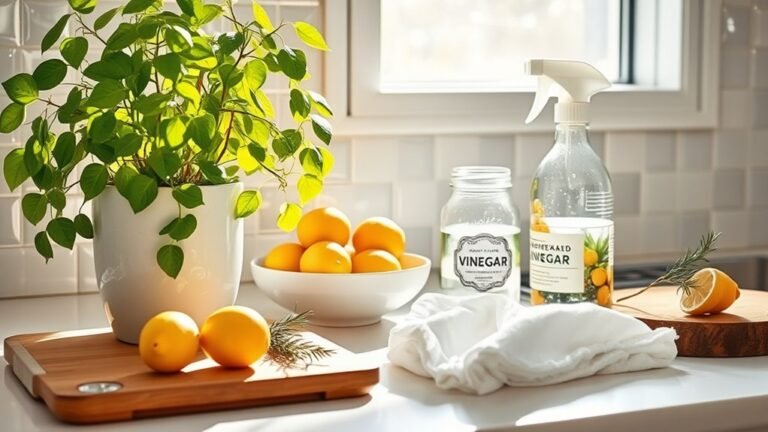How to Remove Sticky Tape Residue From Windows
To remove sticky tape residue from your windows, start by gently cleaning the area with warm soapy water to soften the adhesive. If that doesn’t work, try spraying a solution of equal parts vinegar and water, letting it sit, then wiping clean. For tougher spots, rubbing alcohol or a commercial adhesive remover can help—just apply carefully and wipe off. Taking your time avoids scratching. Keep these steps in mind, and you’ll find even more easy methods to restore your glass’s sparkle.
Tools and Materials Needed
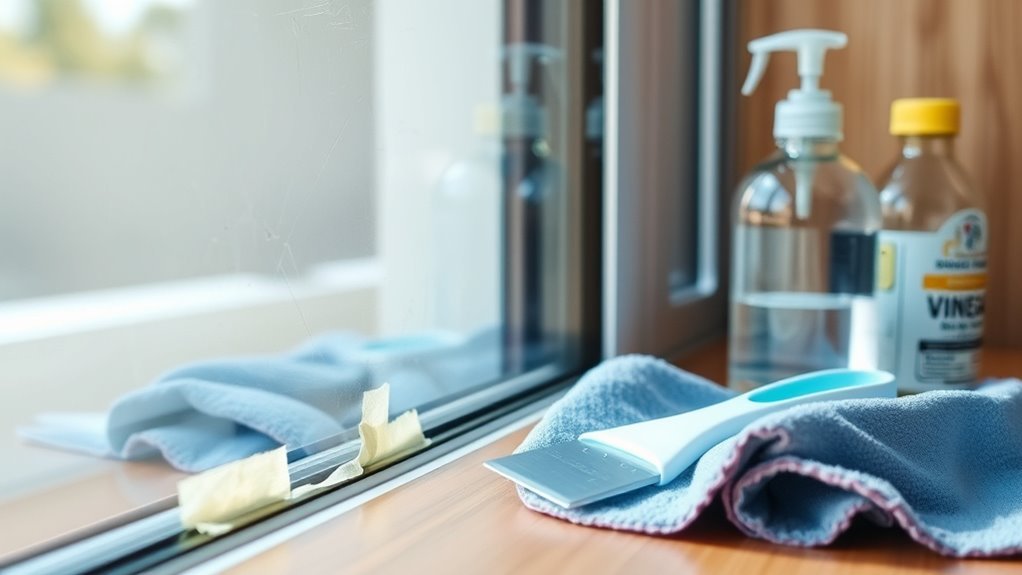
Before you begin removing sticky tape residue, you’ll need a few essential tools and materials to make the process easier and more effective. Different adhesive types leave varied residue effects, so having the right supplies is key to regain your window’s clarity and your freedom from sticky messes. You’ll want a plastic scraper or an old credit card to gently lift the residue without scratching the glass. Keep some microfiber cloths handy for wiping away loosened adhesive. For tougher adhesive types, rubbing alcohol or a commercial adhesive remover can break down residue effectively. A spray bottle with warm soapy water will help soften stubborn spots. Preparing these tools guarantees you’re ready to tackle any sticky situation quickly, freeing your windows from lingering adhesive effects.
Preparing the Window Surface
Although removing sticky tape residue might seem straightforward, properly preparing the window surface is crucial for effective results. First, do a thorough window inspection to identify all areas with residue and any potential damage. This step helps you focus your efforts and avoid wasting time. Next, gather your cleaning supplies—make certain you have everything at hand to work efficiently and confidently. Before applying any removal methods, wipe the window gently with a dry cloth to remove loose dirt or dust that could interfere with adhesion removal. Taking these simple steps guarantees you’re ready to tackle the residue without complications, giving you the freedom to restore your window’s clarity quickly and cleanly. Proper preparation sets the stage for success.
Using Warm Soapy Water
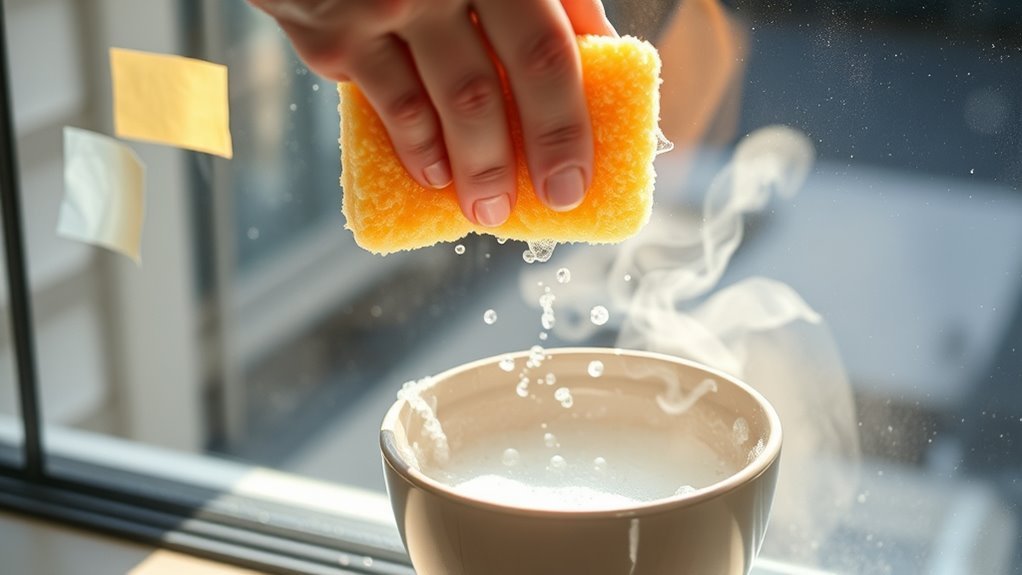
Once your window surface is clean and dry, you can move on to using warm soapy water to tackle the sticky tape residue. Warm water benefits you by loosening the adhesive, making it easier to wipe away without harsh chemicals. Choose a gentle soap type like dish soap or castile soap for effective cleaning without damaging your window. Mix a few drops of soap into a bowl of warm water, then dip a soft cloth or sponge into the solution. Gently rub the sticky area in circular motions, allowing the warm soapy water to break down the residue. Afterward, rinse with clean water and dry the surface with a microfiber cloth. This method frees your windows from sticky messes, keeping them clear and vibrant.
Applying Vinegar Solution
Anyone dealing with sticky tape residue can turn to a vinegar solution for a quick and natural fix. Vinegar properties, like its acidity, make it a powerful cleaning solution that breaks down adhesive without harsh chemicals. To apply, mix equal parts white vinegar and water in a spray bottle. Spray the solution onto the sticky area and let it sit for about five minutes to loosen the residue. Then, use a soft cloth or sponge to gently wipe away the sticky tape remnants. This method respects your desire for freedom from toxic cleaners while effectively clearing the window. Vinegar’s natural ability to dissolve sticky substances makes it a reliable and eco-friendly choice for reclaiming spotless, residue-free glass.
Removing Residue With Rubbing Alcohol
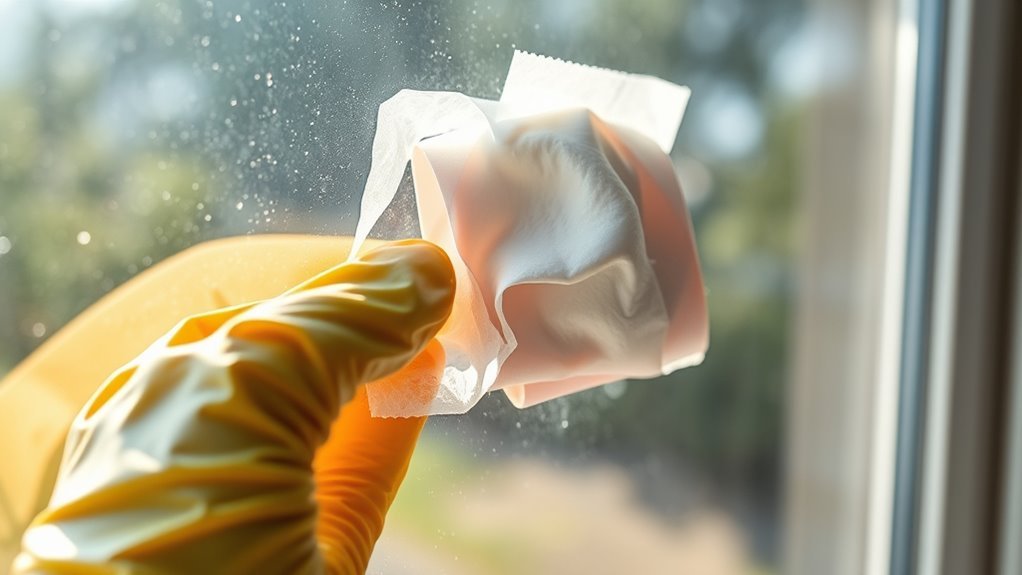
If vinegar solution isn’t quite cutting through the sticky tape residue, rubbing alcohol can be a more potent alternative. Grab some rubbing alcohol and apply a small amount to a clean cloth or cotton ball. Gently rub the residue in circular motions, allowing the rubbing alcohol to break down the sticky substance. You’ll notice the residue starting to lift, making residue removal quicker and easier. Be sure to test a small, hidden area first to verify the rubbing alcohol won’t damage the window surface. Once the residue loosens, wipe the area clean with a damp cloth to remove any leftover rubbing alcohol. This method gives you the freedom to tackle tough sticky tape residue effectively without harsh chemicals.
Utilizing Baking Soda Paste
You can make an effective baking soda paste by mixing it with a little water until it forms a thick consistency. Apply the paste directly onto the sticky tape residue and let it sit for a few minutes. Then, gently scrub and wipe away the residue, leaving the surface clean.
Mixing Baking Soda Paste
Start by combining equal parts baking soda and water to create a thick paste. This simple mixture is a powerful tool in your cleaning hacks arsenal, perfect for tackling sticky tape residue without harsh chemicals. Use just enough water to form a spreadable paste—too runny, and it won’t stick; too thick, and it’ll be hard to apply evenly. Baking soda’s gentle abrasiveness helps break down adhesive bonds, making your windows spotless and free. Mixing this paste yourself gives you control over the texture and guarantees you’re using a natural, budget-friendly solution. With this easy step, you’re one move closer to liberating your glass from stubborn sticky messes, keeping your cleaning routine straightforward and effective.
Applying Paste to Residue
Once your baking soda paste is ready, it’s time to put it to work on the sticky tape residue. The right paste consistency guarantees maximum residue effectiveness without dripping or wasting. Here’s how to apply it like a pro:
- Use a clean cloth or your fingers to scoop up a small amount of paste.
- Gently spread the paste over the sticky residue, covering the entire area.
- Press lightly to help the paste adhere, allowing it to penetrate stubborn sticky spots.
- Let the paste sit for a few minutes to boost its residue effectiveness before moving on.
Removing and Cleaning Residue
Although the baking soda paste needs some time to work, you can now begin removing the sticky residue by gently rubbing the area with a damp cloth or sponge. Apply steady, light pressure to avoid scratching your window while loosening the adhesive. If some residue clings stubbornly, reapply the paste and let it sit a bit longer before trying again. Once the sticky residue removal is complete, wipe the window with a clean, damp cloth to remove any leftover baking soda. This process not only clears the surface but also aids in adhesive residue prevention, helping your windows stay cleaner longer. By taking these simple steps, you’ll enjoy clear, residue-free windows without harsh chemicals, giving you the freedom to maintain your space naturally and effectively.
Employing Commercial Adhesive Removers
When tackling sticky tape residue, picking the right commercial adhesive remover is key to getting the job done effectively. You’ll want to follow the application instructions carefully to avoid damaging your surface. Also, don’t forget to use gloves and work in a well-ventilated area to stay safe.
Choosing Effective Removers
If you’re dealing with stubborn tape residue, commercial adhesive removers can be a real time-saver. Choosing the right remover type is key to freeing your windows from sticky messes without damage. Here are four residue solutions to contemplate:
- Citrus-based removers – gentle, eco-friendly, and effective on light to moderate residue.
- Solvent-based removers – powerful for tough, old adhesive but use cautiously.
- Alcohol-based solutions – great for quick cleanup and less harsh than solvents.
- Gel removers – cling to vertical surfaces, giving you more control and less mess.
Picking the right remover lets you reclaim your space with ease and freedom. Stay mindful of the remover type, matching it to the residue’s strength for smooth, residue-free windows.
Application Tips and Safety
Since commercial adhesive removers can vary in strength and chemical makeup, you’ll want to follow specific application steps and safety guidelines to protect both yourself and your surfaces. Mastering proper application techniques guarantees effective residue removal without damage. Always wear gloves and work in a well-ventilated area to observe safety precautions.
| Step | Action | Tip |
|---|---|---|
| 1. Preparation | Clean the window surface | Remove dirt for better adhesion |
| 2. Application | Apply remover sparingly | Use a soft cloth or cotton swab |
| 3. Wait | Let it sit for a few minutes | Don’t rush the dissolving process |
| 4. Removal | Wipe residue gently | Avoid harsh scrubbing to prevent scratches |
Following these steps gives you freedom to clean efficiently and safely.
Tips for Preventing Tape Residue
Although tape is incredibly useful, it can leave behind frustrating residue if you’re not careful. To keep your windows clear and free from sticky messes, taking preventive measures is key. Here are four straightforward tips to help you avoid tape residue and maintain your freedom from sticky cleanup:
- Choose tape alternatives like painter’s tape or static cling decals designed to peel off cleanly.
- Apply tape to a clean, dry surface to reduce adhesive bonding.
- Limit tape application time; don’t leave it stuck for days or weeks.
- When removing tape, pull it back slowly at a sharp angle to minimize leftover glue.
With these strategies, you’ll enjoy the benefits of tape without the hassle of sticky residue.
Safely Cleaning and Polishing the Glass
Before you start cleaning, make certain to gather gentle, non-abrasive supplies that won’t scratch your glass. You’ll want a soft microfiber cloth, a mild glass cleaner or a vinegar-water solution, and a spray bottle for easy application. When applying the cleaner, avoid harsh scrubbing—light, circular motions protect the surface and guarantee even glass care. Keep your movements gentle to prevent damage and preserve surface protection. After cleaning, use a dry microfiber cloth to polish the glass, enhancing clarity and shine without streaks. Taking these steps not only removes any remaining residue but also maintains your freedom to enjoy spotless windows without worrying about scratches or damage. Proper glass care is key to keeping your windows crystal clear and protected for the long haul.
Frequently Asked Questions
Can Tape Residue Damage Window Tinting?
Imagine your window tinting as a delicate butterfly wing, its durability tested by sticky tape’s adhesive types. If you’re careless, that sticky residue can act like a stubborn spiderweb, damaging the tint’s surface and weakening its lifespan. You want your tinting to stay strong, free from blemishes that limit your view and freedom. So, be gentle removing tape, using products safe for tint, preserving its clarity and your sense of open skies.
Is It Safe to Use a Razor Blade on Windows?
When it comes to razor blade safety, you’ll want to be careful using one on windows. If you hold it at a low angle and use gentle pressure, it’s usually safe for window cleaning, especially on glass without tint. Just avoid dragging it harshly to prevent scratches. Always keep the blade clean and sharp, and test a small area first. That way, you’re free to clean effectively without risking damage.
How Long Should Adhesive Removers Sit on Residue?
Ever wonder how long you should wait for adhesive removers to work their magic? The answer depends on the adhesive types you’re tackling. Generally, letting the remover sit for 5 to 10 minutes gives it enough time for effective residue removal without damaging surfaces. Don’t rush freedom from sticky messes—patience guarantees the remover breaks down the glue, making your cleanup smoother and your windows spotless.
Can Tape Residue Cause Permanent Stains on Glass?
You might worry if tape residue can cause permanent stains on glass, but usually, it won’t if you act quickly. To avoid lasting marks, follow residue prevention tips like removing tape soon after application and using proper glass cleaning methods. If you’re free to clean regularly, you’ll keep your windows clear and stain-free. Just don’t let that sticky mess sit too long, and you’ll enjoy spotless glass without hassle.
Are There Eco-Friendly Alternatives to Commercial Removers?
Oh sure, why not just douse your windows in chemicals when you could embrace nature’s freebies? You can easily whip up an eco-friendly vinegar solution that cuts through sticky tape residue without the guilt. Lemon juice is another powerhouse—its natural acidity breaks down adhesives while leaving your freedom intact from harsh toxins. So, if you want to liberate your windows and the planet, these simple, green alternatives have got your back.



